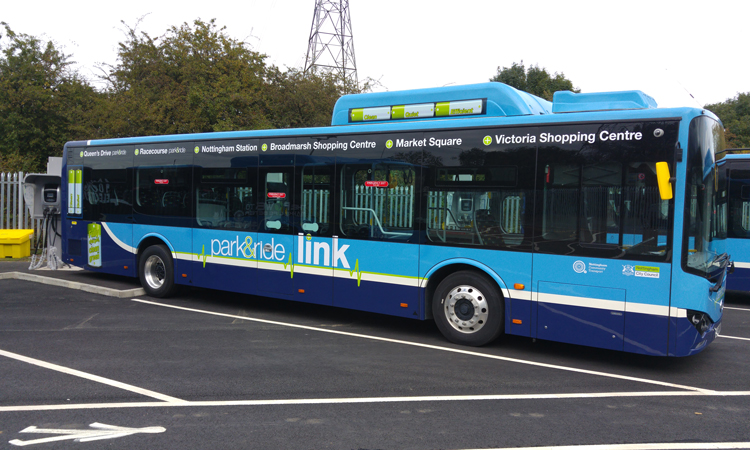Nottingham’s heart beats with electric buses
- Like
- Digg
- Del
- Tumblr
- VKontakte
- Buffer
- Love This
- Odnoklassniki
- Meneame
- Blogger
- Amazon
- Yahoo Mail
- Gmail
- AOL
- Newsvine
- HackerNews
- Evernote
- MySpace
- Mail.ru
- Viadeo
- Line
- Comments
- Yummly
- SMS
- Viber
- Telegram
- Subscribe
- Skype
- Facebook Messenger
- Kakao
- LiveJournal
- Yammer
- Edgar
- Fintel
- Mix
- Instapaper
- Copy Link
Posted: 30 November 2016 | Andy Gibbons - Nottingham City Council, Ian Combellack - Nottingham City Council, Steve Cornes - Nottingham City Council | No comments yet
In 2012 the UK’s Nottingham City Council commenced a six year project to convert its whole tendered ‘Linkbus’ fleet to fully electric buses. The Electric Bus Project has been delivered in close partnership with Nottingham Community Transport, following the award of operating tenders. Here, project colleagues Andy Gibbons, Ian Combellack and Steve Cornes provide funding and vehicle specification details and outline the project’s overall objectives.


Objectives
The project has three main objectives: to cut operating costs; improve air quality; and reduce noise pollution.
Nottingham City Council (NCC) has had to reduce its public transport budgets by £4 million per annum over the past three years. Purchasing electric buses for its tendered service network was seen as a key way to make substantial savings without cutting service provision.
Nottingham is a designated Clean Air City and has Go Ultra Low City and Company status. As such, it is one of five UK cities with a commitment to introduce a Clean Air Zone with Euro 6 emission entry standards for buses by 2020.
Nottingham is a compact accessible city with excellent network coverage by bus, with long operating hours matching its 24/7 expanding economy. Virtually all routes terminate in the heart of the city centre using around 100 bus stops on streets with high pedestrian activity.
There are many residential, health and educational buildings very close to major bus routes. As such it is important that the buses in Nottingham have both low exhaust emissions and are as quiet as possible. Electric buses are much quieter in operation than diesel and have less ground borne vibration, which benefits pedestrians, residents, passengers and drivers.
Funding
Funding for the £15.1 million project has to date come from two principal sources: The Department for Transport (DfT) Green Bus Funding Round (GBF) and NCC’s workplace parking levy. Further funds were received from the DfT Local Sustainable Transport Fund, Plugged in Places, OLEV and the EU REMOURBAN Project.
Specification
The project was designed to meet the following specifications:
- Cope with a range of different types of service – low and high frequency, different capacities and operating hours
- Operate from several existing neutral charging bases, allowing flexibility of contracting operator
- Have a widespread network of daytime rapid chargers to increase network flexibility and efficiency
- Take advantage of cheap night time electricity produced from the Council’s waste incineration equipment
- Act as a showcase demonstration city for electric buses
- Have limited on-street construction works with the flexibility to readily change routes and timetables
- Be relatively easy for any contracting operator to utilise.
Stage one – midibuses
For the first stage of the project 45 Optare EV midibuses were purchased, replacing existing Optare diesel buses of a similar size over a three year period. These have a range of approximately 70 miles and run on services where a single daytime rapid charge can be timetabled – usually during the driver lunchtime break. They also require overnight trickle charging.
The majority of the buses are 9.2m Solos with 31 seats and 12 standees. There are also 10 10.4m Versas with 33 seats and 25 standees, which are used on the busier Medilink Park and Ride routes to two outer lying hospitals, taking some 1.4 million passengers a year.
These buses have been utilised on a mix of low and high frequency routes, with seven 50kw rapid charging points at four locations, including a central bus station and park and ride site. The high frequency Centrelink route operates only in the city centre and takes roughly 500,000 passengers a year. The Localinks and Worklinks cover a network of routes over the whole conurbation, some with demand responsive elements. All buses also require overnight trickle charging (using 2 x 7.5kw on-board chargers) with 53 of these points installed at various overnight depot areas.
These buses have now reached one million miles of operation since service commenced in September 2012.
This has generated savings in well-to-wheel emissions of at least 1,050 tonnes CO2. This is equivalent to 222 passenger vehicles driven for one year, or the amount of carbon it would take 27,212 trees grown from seedlings 10 years to absorb.
In addition, 15 tonnes of NOx savings have been achieved, with small particulate (less than 10 microns) reductions of at least 83kg, when compared with equivalent Euro 5 diesel buses. These particles are harmful to health, especially particles of less than 4 microns (PM4) in size, which are able to evade all bodily defences and enter the bloodstream. These have recently been discovered to have major implications for heart health.
The fuel cost savings of an electric bus when compared with a comparable diesel bus, and including the six pence per km DfT Low Carbon Emission Bus Incentive Grant, are around 85%. There are further savings due to lower maintenance costs (around 40%) and no liability for vehicle excise duty. Analysis of operating figures indicates that, on average, the buses are travelling around 1km per kilowatt hour of electricity consumed.
The savings in fuel costs as a result of using these first 45 buses instead of diesels has been approximately £300,000 per year. This has enabled these services to be maintained in the face of severe cuts to council resources over the past five years.
Stage two – saloons
The second stage of the project focuses on the two main park and ride services to the city centre: these have long operating hours (up to 18 hours per day); high daily mileage (up to 180 miles); and require larger capacity buses to cope with peak demand. Following an open tender process, 13 x 12m-long EBus saloons from BYD were purchased, each with two battery packs. These are able to operate for the full daily timetable without in service daytime charging. Charging takes place over a 5-hour period at night, utilising low-cost electricity tariffs. These require different charging equipment to the Optare vehicles and a separate base has been built to store and charge these vehicles. They come into operation in two phases in October 2016 and January 2017, coinciding with operating tender changes. We predict further operational savings of £200,000 per annum compared with the current buses.
Over the five year period there have also been several changes to operational tenders. All buses – both Optare and BYD – are now operated by Nottingham Community Transport, the majority of which are run and charged from two dedicated charging compounds within a park and ride site some two miles from the city centre. This has now become a high profile demonstration site for electric buses – the Queens Dr Ecohub – hosting visits from many other cities.
Stage three – charging network expansion
The charging network will be increased over the next two years using the Office for Low Emission Vehicles Low Emission Bus Scheme Grant (LEBS), with plans for an expansion in current facilities along with the installation of a network of rapid chargers for electric bus use at strategic points around the city. This will make the whole operation more efficient and flexible, bringing future operational cost savings of around £200,000 per annum for an additional investment of £1.2 million.
The BYD new buses come equipped with state-of-the-art telemetry systems that will also be retrofitted to the Optare buses in the near future. These provide detailed information about the vehicle (location, battery range remaining, use of regenerative braking etc.) and will allow more efficient future service operations and detailed feedback on driver performance.
In recognition of the achievements of the first stage of the project, it was awarded Gold in the UK Bus Awards Environment category in 2015.
The future
By January 2017 electric buses will run on nearly all of Nottingham City Council’s Link Bus Services – a network of routes to workplaces, health and education sites and district centres, with six million trips a year. The remaining three services will be converted to electric by 2018 using existing buses, following increased efficiencies resulting from the planned expansion in the charging network in 2017.
The partnership with Nottingham Community Transport has now gained significant experience in this emerging area, with Nottingham being one of the foremost electric bus cities in Europe. Being an early adopter of such cutting-edge technology hasn’t been easy, but the partnership has now achieved a reliable electric bus network in close collaboration with Redferns, Optare, APT Controls, Circontrol and BYD. Redferns of Mansfield provide the key local engineering input, including full servicing and warranty work for both bus types.
It is hoped that other bus operators and contractors within Nottingham will make use of this charging network and local expertise. Nottinghamshire County Council has recently confirmed it will be purchasing some electric buses for its fleet. Other large contractors, such as the Universities, are well placed to follow suit.
Nottingham is now putting electric buses at the heart of upcoming demonstration corridor schemes. In October 2016 it commenced construction of an ‘Eco Expressway’ to the east of the city centre, incorporating one of the BYD park and ride services on an expanding ‘growth’ corridor for retail, light industry and housing. This Expressway will include 5km of priority bus lanes to improve journey times and reliability of the electric bus service.
The priority lanes will also be open for use by any Ultra Low Emission Vehicle (ULEV) in order to stimulate the uptake of ULEVs within Nottingham. The bus lanes are programmed to become operational by the end of 2017, together with improvements to bus stops, pedestrian crossings points and bus priority at signals.
In addition the city council will shortly be consulting on plans to introduce a low emission bus zone over the next three years, incorporating over 100 bus stops and two bus stations across the city centre. This will aim to set a minimum entry standard of Euro 5 by 2018 and Euro 6 by 2020, with ultra-low emission standards for certain sensitive areas with high pedestrian use.
Biographies






Related topics
Air Quality, Alternative Power, Fleet Management & Maintenance, Sustainable Urban Transport
Issue
Issue 6 2016
Related modes
Bus & Coach, Electric bus
Related cities
Nottingham
Related organisations
Nottingham City Council
Related people
Andy Gibbons, Ian Combellack, Steve Cornes







